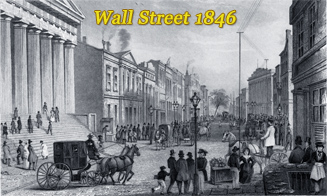
Wall Street in 19th century
Wall Street was an important business and financial area on New York since late 18th century. In 1800, the population of New York City was 60 thousand people and grew to 3.4 million by 1900.
The New York Stock Exchange was founded in 1792. It first opened in February that year, at 22 Wall Street, for the accommodation of the dealers in stock, and in which public sales was held at noon as usual in rotation by A. L. Bleecker & Sons, J. Pintard, McEvers & Barclay, Cortlandt & Ferrers, and Jay & Sutton. In 1817 the organization was named the New York Stock & Exchange Board and rented space at 40 Wall Street. The present building was completed in 1903.
The Custom House (now Federal Hall National Memorial) opened in 1842 on the site of the old Federal Hall. It was occupied by the U.S. Sub-Treasury in 1863.
In 1835, many buildings in Wall Street were destroyed by the Great Fire, including the old Merchants' Exchange building and the First Presbyterian Church.
The Merchants' Exchange Company was incorporated in 1823 and its original building was completed in 1827, at present 55 Wall Street. After it was burned down in 1835, architect Isaiah Rogers was commissioned to design a new larger building, which began to be erected in 1836. The new Merchants' Exchange building, opened on November 17, 1841, and the building was completed in 1842. The Exchange failed in the mid-century and the building became the New York Customs House in 1863.
The Wall Street Ferry opened in 1853, connecting to Brooklyn Heights, where many Wall Street men lived.
The old Drexel Building, on the corner of Broad Street, was built in 1872-1873 for Drexel Morgan & Co., succeeded by J.P.Morgan & Co. in 1895. The building was demolished before 1914.
During the Blizzard of 1888, the Stock Exchange closed for two days. By 1889 (after April), utility poles were removed and overhead wires were buried in Wall and Broad streets. The asphalt pavement was laid down in 1890.
Eighty-four chartered banks were in active business in New York City in January, 1889. Of these, 45 were national and 39 state institutions. There were then in the United States 3157 national, 2348 state, 4210 private, and 609 savings banks proper — 10,324 banks in all.
Wall Street was crowded during the Great Financial Panic of 1873, which started when the stock market crashed in Europe and investors began to sell off investments they had in the United States. Another panic in 1893 led to an economic depression in the United States, which ended in 1897. More: Wall Street in 18th century ►

Fragment of View of New York City and Brooklyn by William Simpson, about 1851, showing Wall St. and surroundings.
|
Copyright © Geographic Guide - Images of NYC in 19th Century. |
Wall Street in 19th century

Merchants' Exchange